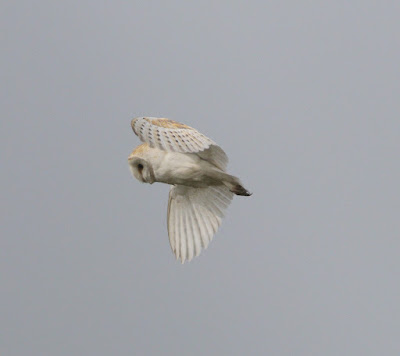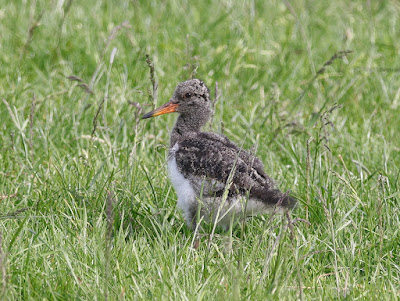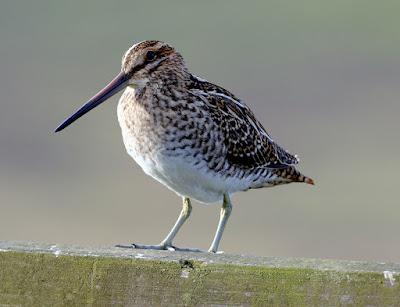I found myself looking at Starlings this morning. Yes, those noisy, mucky pests that carry the very appropriate Latin title of Sturnus vulgaris. For readers not up to speed with the latest rarity news, there has been an influx of Rose-coloured Starlings into Western Europe and the UK from the pink ones’ normal area of easternmost Europe and southern Asia. In those parts the species inhabits steppe and open agricultural land but when they turn up here in the UK they might be found in almost any habitat that resembles their original.
An adult Rosy Starling looks nothing like our Common Starling but for the next few weeks it’s a good idea to check out any post-breeding Starling flocks as the juveniles of each species have a closer likeness.
All of a sudden there are a lot of Starlings around this week with flocks here and there and 90% of them fresh juveniles.
All of a sudden there are a lot of Starlings around this week with flocks here and there and 90% of them fresh juveniles.
Rose-coloured Starling
Common Starling
Good and bad news from Conder Green. A mink scurried along the water’s edge, glistening black from its dip in the creek before it disappeared into the grass. This was my first sighting here of this non-native terrorist, the originals of which were escapees from fur farms and those released by misguided Disney-heads.
Mink - Pdreijnders CC BY-SA 3.0, Wikimedia Commons
Unsurprisingly the watery creeks held little apart from a handful of Redshank, Oystercatcher, Lapwing and Shelduck, plus singles of Curlew, Grey Heron and Little Egret.
Fortunately the story on the pool was much better with proved breeding from a number of birds and a "maybe" from a single Little Ringed Plover that is unlikely to be alone. On the nearest island an Oystercatcher had three chicks, vying for the limited space with four fresh out-of-the-egg Redshank chicks. Play “Spot the Chick” in the picture below.
Otherwise - a pair of Avocet in the throes of egg sitting, 18 Tufted Duck and at least 4 more pairs of Oystercatcher with more small young.
There are still two pairs of Common Tern, one pair with chicks, all of them joined briefly today by two other Common Terns that flew in from the estuary. After a few very noisy but brief skirmishes the would-be interlopers flew back from whence they arrived out to the River Lune.
I completed a circuit of the lanes from Conder Green via Jeremy, Moss etc. to estimate the passerines hiding in the ditches and hedgerows with singing counts of 12 Tree Sparrow, 8 Sedge Warbler, 6 Whitethroat, 3 Reed Warbler, 5 Reed Bunting, 4 Pied Wagtail, 2 Willow Warbler and 2 Blackcap
I drove back via the moss roads to find more juvenile Starlings, a day flying Barn Owl, 4 Buzzards and a single Yellowhammer belting it out from on high. A Yellowhammer is quite a find nowadays, almost rarer than a Rosy Starling.
That’s all for now folks. Another Bird Blog is back soon with more colourful bird tales.
Linking today to World Bird Wednesday and Anni's Saturday Blog.
P.S.
Kelly - Community Manager @ Google 31 May
Hi everyone. We are aware that there is an issue where users are not receiving email notifications for comments. We're currently tweaking our emailing system, but we expect it to be working again soon. Thank you for your patience - we appreciate it!
Kelly - Blogger Community Manager
Fortunately the story on the pool was much better with proved breeding from a number of birds and a "maybe" from a single Little Ringed Plover that is unlikely to be alone. On the nearest island an Oystercatcher had three chicks, vying for the limited space with four fresh out-of-the-egg Redshank chicks. Play “Spot the Chick” in the picture below.
Redshanks
Otherwise - a pair of Avocet in the throes of egg sitting, 18 Tufted Duck and at least 4 more pairs of Oystercatcher with more small young.
There are still two pairs of Common Tern, one pair with chicks, all of them joined briefly today by two other Common Terns that flew in from the estuary. After a few very noisy but brief skirmishes the would-be interlopers flew back from whence they arrived out to the River Lune.
I completed a circuit of the lanes from Conder Green via Jeremy, Moss etc. to estimate the passerines hiding in the ditches and hedgerows with singing counts of 12 Tree Sparrow, 8 Sedge Warbler, 6 Whitethroat, 3 Reed Warbler, 5 Reed Bunting, 4 Pied Wagtail, 2 Willow Warbler and 2 Blackcap
Tree Sparrow
Pied Wagtail
I drove back via the moss roads to find more juvenile Starlings, a day flying Barn Owl, 4 Buzzards and a single Yellowhammer belting it out from on high. A Yellowhammer is quite a find nowadays, almost rarer than a Rosy Starling.
Barn Owl
Barn Owl
Barn Owl
Yellowhammer
That’s all for now folks. Another Bird Blog is back soon with more colourful bird tales.
Linking today to World Bird Wednesday and Anni's Saturday Blog.
P.S.
Kelly - Community Manager @ Google 31 May
Hi everyone. We are aware that there is an issue where users are not receiving email notifications for comments. We're currently tweaking our emailing system, but we expect it to be working again soon. Thank you for your patience - we appreciate it!
Kelly - Blogger Community Manager






























































.jpeg)




.jpg)













